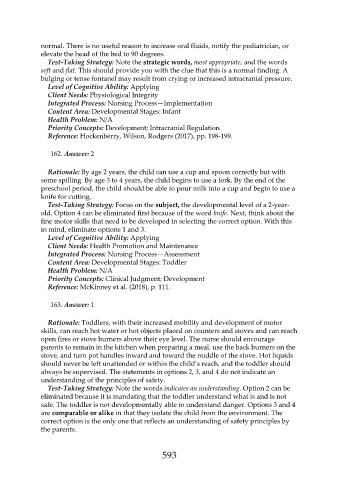Page 593 - Saunders Comprehensive Review For NCLEX-RN
P. 593
normal. There is no useful reason to increase oral fluids, notify the pediatrician, or
elevate the head of the bed to 90 degrees.
Test-Taking Strategy: Note the strategic words, most appropriate, and the words
soft and flat. This should provide you with the clue that this is a normal finding. A
bulging or tense fontanel may result from crying or increased intracranial pressure.
Level of Cognitive Ability: Applying
Client Needs: Physiological Integrity
Integrated Process: Nursing Process—Implementation
Content Area: Developmental Stages: Infant
Health Problem: N/A
Priority Concepts: Development; Intracranial Regulation
Reference: Hockenberry, Wilson, Rodgers (2017), pp. 198-199.
162. Answer: 2
Rationale: By age 2 years, the child can use a cup and spoon correctly but with
some spilling. By age 3 to 4 years, the child begins to use a fork. By the end of the
preschool period, the child should be able to pour milk into a cup and begin to use a
knife for cutting.
Test-Taking Strategy: Focus on the subject, the developmental level of a 2-year-
old. Option 4 can be eliminated first because of the word knife. Next, think about the
fine motor skills that need to be developed in selecting the correct option. With this
in mind, eliminate options 1 and 3.
Level of Cognitive Ability: Applying
Client Needs: Health Promotion and Maintenance
Integrated Process: Nursing Process—Assessment
Content Area: Developmental Stages: Toddler
Health Problem: N/A
Priority Concepts: Clinical Judgment; Development
Reference: McKinney et al. (2018), p. 111.
163. Answer: 1
Rationale: Toddlers, with their increased mobility and development of motor
skills, can reach hot water or hot objects placed on counters and stoves and can reach
open fires or stove burners above their eye level. The nurse should encourage
parents to remain in the kitchen when preparing a meal, use the back burners on the
stove, and turn pot handles inward and toward the middle of the stove. Hot liquids
should never be left unattended or within the child’s reach, and the toddler should
always be supervised. The statements in options 2, 3, and 4 do not indicate an
understanding of the principles of safety.
Test-Taking Strategy: Note the words indicates an understanding. Option 2 can be
eliminated because it is mandating that the toddler understand what is and is not
safe. The toddler is not developmentally able to understand danger. Options 3 and 4
are comparable or alike in that they isolate the child from the environment. The
correct option is the only one that reflects an understanding of safety principles by
the parents.
593

